Posted At: Oct 02, 2023 - 247 Views
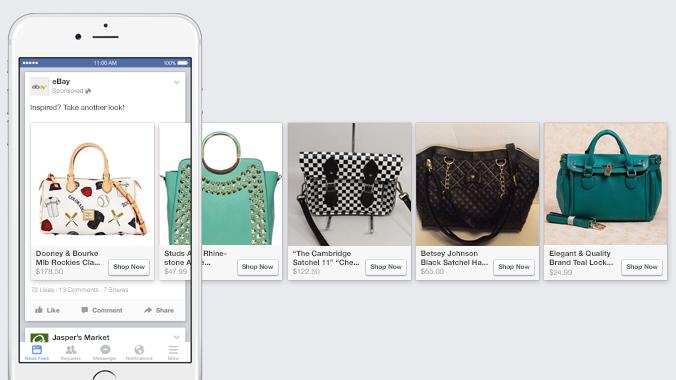
So, you want to know how to run a CPR promotion using Amazon Facebook ads, eh?
Maybe you’ve tried before, failed, and don’t know why. Cue in the garlic press—one of the greatest successes on Amazon that ended up being heavily saturated.
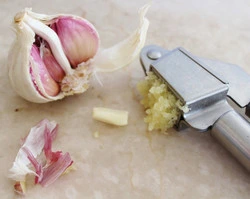
But before the big boom, you might’ve thought to yourself, “It’s a garlic press. No one wants to buy a garlic press on Facebook,”. Ah yes, the garlic press… it is now forever engraved as an age-old running joke in the Amazon community.
But what caused its popularity spike? Well, someone managed to sell the crazy thing first.
Today, we’re going to get good at selling products like the garlic press through Amazon Facebook ads. In fact, we’re going to get good at selling just about any damn thing.
If you watched any of Manny Coats’ videos, you’ll know how much he loves tactical flashlights in his videos. Heck—we’ll set up a Facebook ad campaign for that too.
In a bit, I’m going to show you one of my own ads. It’s the same one that I mentioned in my previous post about using Facebook Offers to distribute Amazon coupons.
It had a 120% conversion rate, and I coughed up just $0.07 per click.
Are you wondering how?
First, I put it together for a CPR promotion, hence the low price tag. But more importantly, I understood that Facebook ads aren’t just about enticing offers and effective demographic targeting.
A third equally important factor is your messaging.
Now, gird up. I’m about to teach you how to create a Facebook advert that serves as the ultimate lead magnet for conversions. We’re going to turn all your CPR launches into successes.
Remember, I’m going to offer a few peeks into my own Amazon Facebook ads.
Okay. Now, let’s go to work.
Facebook Marketing Is Interruption Marketing
This is the first point you have to grasp before you running any kind of successful Amazon Facebook ad. Unlike Google Ads or Amazon PPC where people are actively searching for what you have to offer, people on Facebook are not looking to buy your garlic press.
If you were running a Google ad, then you might include some keyword phrases like “buy a garlic press” or “best garlic press”.
But that’s just not how Facebook works.
The best kind of advertising strategy on Facebook is to interrupt potential customers from whatever else they were doing. Your ad content must convince them that they need to stop, check out your product, and click the buy button—preferably NOW!
One of the best methods to do this is through your “ad creative”.
Here’s an example of ad creative I ran a while back (I bet it popped right into your eyes as you were scrolling down the page).
Now, you tell me. If you saw this picture in your news feed, wouldn’t the ad image below at least make you look?
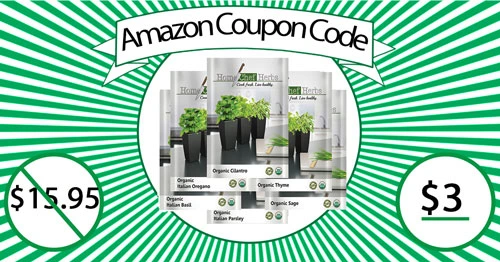
Facebook Ad Images Are Like Amazon Supplemental Images
Sometimes, sellers go straight for the attention-grabbing image like the one above and rely on their copywriting to sell the product. But many times, it’s better to make the image work a little more for you.
Let me explain.
I posted my opinion on the High Rollers Facebook Group about how Facebook ad creatives serve a similar purpose as Amazon listing images.
I also mentioned that there are three types of ad creatives (images) to go for:
- Images which invoke a little trust (celebrity, influencer, a popular brand, USDA, etc.)
- Images which convey an excellent offer too good to pass up (discounts)
- Images which reflect your ad’s hook (the benefit of using your stuff)
The more images you can incorporate, typically the better, but testing your images to see which ones resonate with your audience the most is best.
That leads us to “the hook”. Remember your 6th grade English class? If you don’t remember what a “hook” is, we’ll get to that in just a moment.
You probably didn’t pay attention in 6th grade, but you will want to pay attention now because it’s crucial to convincing people to buy your product today.
Let’s backtrack a little. Remember how I said that creating a Facebook ad image to capture attention is very much like what your Amazon product listings are meant to do?
Generally, the primary product image on Amazon is meant to show everything off about a product’s features. Facebook ad creatives are more like a product’s secondary images. They should show off the benefits of your product and not just its features.
The real goldmine lies with your supplemental images since they’re the ones that really reach out to the customer to convince them to buy your product.
A good set of supplemental images on our Amazon listings do things like:
- Tell a story
- Show the benefits of the product
- Demonstrate how it’s used
- Build a little trust
- Give the customer a sense of beginning to say, “This is for me.”
They are not there to show:
- What the product looks like from the side
- What the product looks like from the back
- The packaging it comes in
- How it’s red, not blue
Tip: Don’t ever use those photos of silhouettes holding your product (You’ve seen these, right?)
If your images don’t do what they’re supposed to, you’ll end up steering potential customers to buy someone else’s product. Your creatives should grab the attention of your potential customers to invoke an emotional response or demonstrate a useful benefit that convinces them to buy.
Let’s Study Some Ads
Let’s talk about ad copy length. Some are short as one or two sentences, but others can be like a full-blown blog post.
If your ads are targeting a cold audience, writing more to provide more information in your ad copy might be a good idea.
The copy below is from a Facebook ad I ran for potted herbs. This creative managed to get more clickthroughs than ever before. It’s a good example of the points I’ve made above:
- It’s Non-GMO / USDA Organic (trust, feature)
- It’s fresh and healthy (advantage, benefit)
- You can grow a lot of it and save money (advantage, benefit)
In one of my previous blogs on Facebook offers, I conducted a live promotion for the sake of demonstration.
Mind you, but the ad wasn’t for an official Amazon product launch or promotion. I just went through the motions to demonstrate how to set up an effective Facebook Offer.
But I actually managed to get sales before shutting it down.
It was turned off too soon to gather concrete ad performance data, but it seemed very promising. Here’s what happened:
You can watch the video here.
Here’s what was sent out:
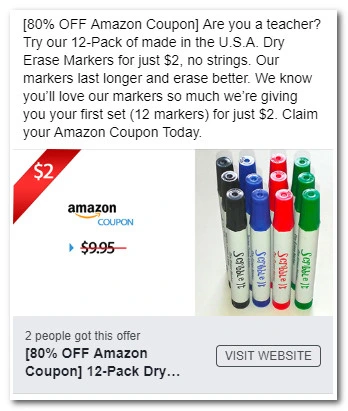
How do you think it performed?

The ad reached 48 people. Out of those 48 people, 2 of them clicked through to purchase. I spent $0.46 on each of them.
Let’s do a little math to figure out the conversion rate:
Conversion Rate = Sales / Link Clicks *100
2 Sales / 2 Link Clicks * 100 = 100% Conversion Rate
Doesn’t 100% have a nice ring to it? Hell yes, it does. By learning how to pull off something similar, you can scale the method and improve on it.
Are you asking “how”? It’s impossible to beat 100%, right?
Well, it’s not all about the conversion rate. You can try and optimize and bring your cost-per-click down. If your ad manages to get shared in various Facebook groups, your conversion rate will show higher than 100%.
Remember that 120% conversion rate I mentioned at the beginning of this article? Here’s how I got it:
We were promoting the same dry erase markers, but this time I was running an actual CPR promotion. We targeted the exact same audience demographics, but instead of using a short ad copy, I colored in a little more detail to help sell it.
Here’s the ad:
And when they clicked “Learn More” to read more of the ad, this is what they saw:
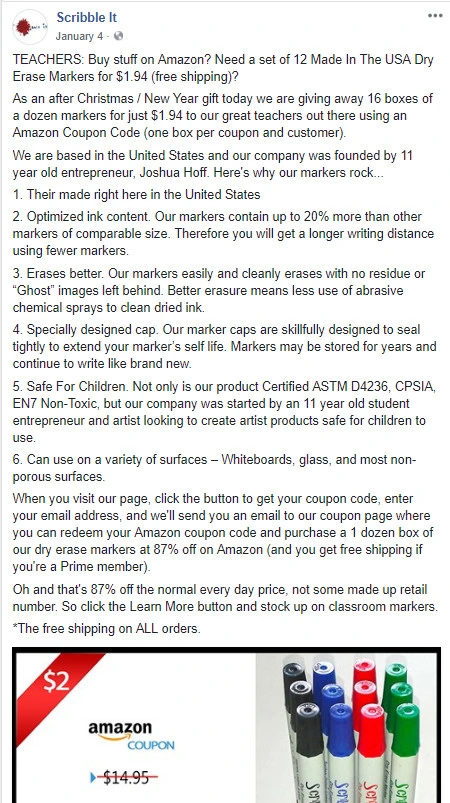
Here are the numbers for that particular day.
I ended up shutting down the promotion early after 12 units were sold because that was more than what I needed.
Here is the ad report:

As you can see, I got 10 clicks at $0.07 per click. For the previous ad with the shorter copy, I paid $0.46 per click, that’s $0.92 for two. I only paid $0.69 for ten clicks of the long copy!
That’s a pretty big improvement over the original, even with a 100% conversion rate.
But it gets even better, here’s how many sales resulted with this longer ad copy:
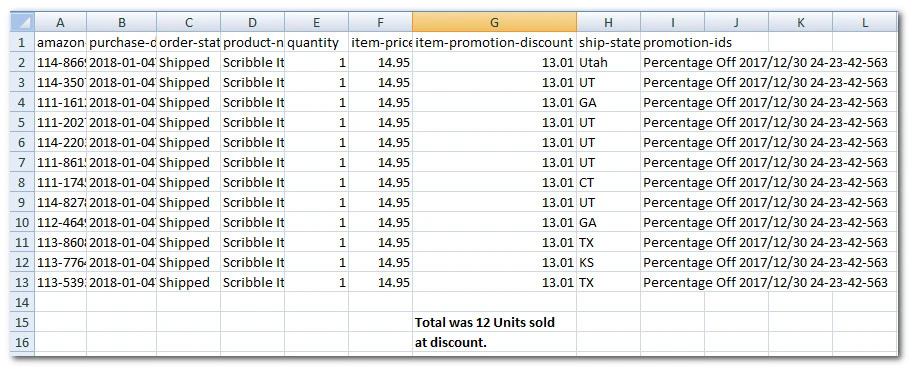
That’s 12 units sold with the promotion, but Facebook only reported 10 Link Clicks.
How is this possible?
After asking customers how they found our product offering after I turned off my ad, they replied that they shared the promotion on a Facebook group they were in. The shares kept going.
Essentially, I got two extra sales for free.
Now, if we do our math for this promotion, here’s what we get:
- Conversion Rate = Sales / Link Clicks * 100
- 12 sales / 10 Link Clicks * 100 = 120% Conversion Rate
So how do we craft an ad which gets people to take action?
The answer is hidden and uncovered in the next section:
Understanding the Offer, Hook, Customer Avatar, & Messaging
When you create Amazon Facebook ads to sell your product during your promotion, you’re essentially creating an offer. You’re basically saying, “Here’s my product. Here’s a coupon. Now, please go buy it on Amazon for me.”
This is where many people give up. They feel like they’ve done their part by setting up audience targeting and putting up the ad. However, they failed to get people to buy. At this point, they give up to avoid burning a bigger hole in their pocket.
Depending on how much the person your ad targeted really needs your product NOW, a cold sale can get tougher or easier.
Because remember—if they’re not looking for your product, you’re just interrupting them with an offer. It’s like cold-calling with a phone or door-to-door sales.
Cold calling prospects to sell your product is about as tough as it gets. Now, it does get a little easier if we know that the prospect is interested in our product offerings—like vacation packages for an example. And it gets even easier than that if they’re already aware of our brand.
You can drop it down another notch if they’ve done business with us before and enjoyed the experience (a “warm/hot audience”). They’re less likely to hang up immediately.
Apply all this to your Facebook ad.
Let’s say you’re selling garlic presses which most people don’t need IMMEDIATELY. Most people have probably never heard of you, which means that you have to hook them with some tangible benefit to make them feel like they need a garlic press TODAY.
Ideally, the benefit should speak directly to their personal or unique problem (apart from the broad fact that they don’t have to mince garlic by hand).
See? Up-selling often gets harder because the pain point isn’t big enough for most people.
But if you can uncover a specific problem or pain point that is uniquely fitted to a particular audience, then your ad can demonstrate that…and you’ll hit gold.
We’ll get deeper into hidden paint points in just a bit…
Let’s say you’re selling a front right fender for 57′ Chevy’s, and it’s one heck of a deal. It becomes an easier sell when your ad appears to someone who happens to be in need of one. Your ad creative can halt the scrolling and compel the reader to check out your offer; consider the fact that 57′ Chevy fenders are pretty rare and hard to find.
The bigger the problem and the better your product solves it, the easier the sale becomes.
We all know how easy it is to buy things on Amazon.
Understand this: Facebook is about positioning the right product in front of the right audience at the right time.
I’m going to take it one step further and say it that it’s about positioning the right product, in front of the right audience, with the right messaging, at the right time.
Ad Messaging (it’s part of your targeting)
Most people understand the basics of ad targeting. You’re probably familiar with the part where you fill in an age range for your audience, what area they live in, how much money they make and, interests, and etc…
But only a few people really understand that the messaging is just as important as your audience targeting.
IMPORTANT NOTE: Your ad copy should invoke a positive emotional response.
I can’t believe it’s been this long, but eight years ago, I did a guest post on the popular copywriting blog, Copyblogger—it was titled, “How to Use Emotional Copywriting to Kick-Start Your Sales.”
I mentioned how selling (especially these days with the Internet) is about making connections—
whether they are with you and the ones others make in their lives based on the text in your copy.
I mentioned how selling—especially on the internet—is about making personal connections with the words you write.
Here’s an example.
Let’s play with big man Manny Coats’ favorite example, the Tactical Flashlight. Let’s roughly split test Facebook ads for it. You can decide which one will sell better.
Here’s our product:

I’m not into tactical gear, but is it me? Or does that look like a lightsaber?
You don’t want to create a bland Facebook ad that describes how it’s brighter than other flashlights, lasts much longer, or how it attaches to your rifle. They’re great features, but you and I both know that it won’t stand out in a news feed.
Your content needs to make an emotional connection. Hit home on their love for tactical gear and solve their problems and pain points.
Let’s conduct our split test. Which of these ad copies would you go with?
Tactical Flashlight Example Ad 1
Tactical Flashlight Example Ad 2
Start immediately with the top headline. Number 2 creates an instant connection between you and the prospect you’re selling to. You now share their love and enthusiasm for tactical equipment. The first one just lists away the features.
Pay close attention to the text in the second ad copy. It is more likely to make you think, “Yeah, that’s me. Yeah, I’ve got a tactical belt that’s starting to get a bit too heavy.” The content gets to the heart of a pain point.
It’s definitely more likely to help out with audience engagement.
On the other hand, the bland copy in the first example reads like you’re asking the prospect for a favor to please check your product out.
That leads us crafting the hook.
What Is a Facebook Ad Hook?
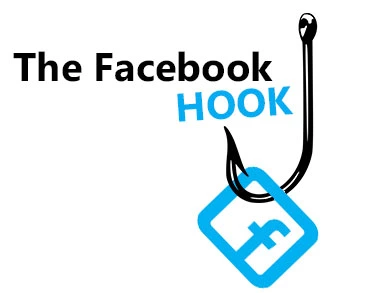
Your offer is the deal you’re giving your potential customers. Let’s say you’re offering an 80% discount on a very unexciting garlic press.
A hook in this case is the reason why someone would want to buy your garlic press. In other words, the hook communicates the benefit of using your product.
It should make your prospect’s life easier, or help them feel faster, smarter, richer, healthier, or better overall, etc.
Now, which of the two is this—a feature or benefit?
“With our garlic press, you don’t even have to peel the garlic; it’ll peel for you.”
If you answered “feature”, then bingo—you’re dead on.
How about this one?
“Spend less time stinking up your hands in the kitchen. Our garlic press squeezes out all the goodness without the stink.”
Prep work takes a while and peeling garlic sucks.
The second example highlights a direct customer benefit while addressing pain points.
Here’s a little trick I use to come up with great hooks:
Do you know how people say that when you want to reach a goal you should try planning it backward?
It’s the method I use to uncover deep reasons behind why someone might want to buy my product. It helps me come up with a good hook.
Start by asking yourself, “Why do they want my product?”
Then, ask “Why?” three to four times. Once you get to the why a few levels deep, you’ll dig up a good emotional hook.
For example, I’m a Paleo/Keto kind of guy. I have to cook just about all my meals. It’s a bit of a hassle, but it makes me feel great. However, the time it takes for me to prepare, eat, and clean up a meal is definitely a pain point.
After prepping, cooking a meal for our family of six, and hopefully getting some help to clean it all up, my day is up. It feels like I’m stuck in the kitchen for hours every night.
Now, let’s tie in the garlic press. Figure out how you would get me to buy it during your CPR promotion.
Ask yourself, “Why would John want a garlic press?”
The Answer: He wants to save time in the kitchen because peeling and mincing garlic is a real pain in the neck.
But don’t stop here! Saving a bit of time in the kitchen is a good start, but it’s not enough to spark a “Yes I need this now” emotional response from me.
Now, ask “why” again one level deeper: “Why does John want to save time in the kitchen?”
The Answer: He can imagine a million other things to do instead of peeling and mincing garlic.
Go one level deeper again and ask, “Why is John peeling the garlic in the first place?”
The Answer: He wants his kids to grow up eating healthy and remember how their dad used to cook the tastiest food ever for the whole family. Maybe one day, they’ll want to learn his special recipes.
Ask one more time: “What can John do with the extra time he can save?”
The Answer: He can spend time with his kids making good memories instead of feeling exhausted with stinky hands after dinner.
Now with all the answers gathered above, here’s how your targeting should go down:
First, target your customer avatar’s demographics in the Facebook Ad Set level (We’ll get more specific on customer avatars in more detail in a bit—it’s SUPER important to know who you’re talking to).
A typical avatar profile includes details like this:
- Male or female between the ages of 35 and 50 and lives in the United States
- Likes cooking channels like the Food Network, Paleo, Keto, Food Network Star, Rachel Ray, Cooking Magazine, etc.
You might even add in that they’re interested in “coupons” or “Amazon”.
But remember, this is just one part of your audience targeting efforts. You need to top it off with the correct audience messaging to complete your targeting process.
Now, instead of writing an ad that plainly says, “Here’s a garlic press for X percent off; go buy it…”
We now know that we have to include the right messaging that speaks to someone like me—a 40-year-old male who and likes to cook for his family and etc.
Here’s a quick ad example:
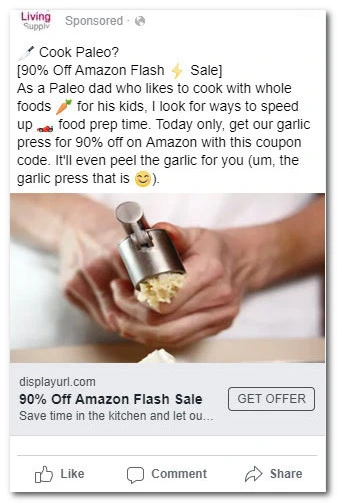
Okay, this isn’t my ad, but it’s the first great example off the top of my head.
Usually, crafting a good ad requires a lot of time. But if you’re doing a deep discount for a CPR promotion, the great things is that you have a HUGE head start with a kickass offer. This makes selling things easier.
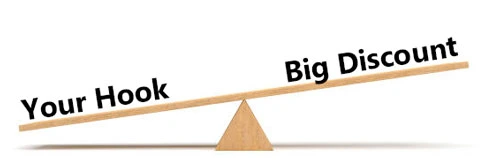
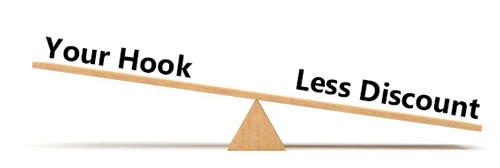
Selling to Your Customer Avatar
Now, let’s get deeper into your customer avatars.
Do you know what a customer avatar is?
Let’s say you have a good idea of one type of customer. Can you describe a few others?
Step back for a moment and let me remind you again.
Facebook marketing is about positioning the right product, in front of the right audience, with the right messaging, at the right time.
If you manage to hit more of the above, the sale will be that much easier.
Let’s zero in on finding the right audience and messaging.
In his book, 80/20 Sales and Marketing, Perry Marshall says:
“Selling to the right person is more important than all the sales methods, copywriting techniques, and negotiation tactics in the world. Because the wrong person doesn’t have the money. Or the wrong person doesn’t care. The wrong person won’t be persuaded by anything.”
We’ll look at one more example to clear up this whole spiel on messaging and multiple customer avatars.
Let’s say you’re selling an electronic padded drum set. You’re want to create some Facebook ads to help you sell your product on Amazon.
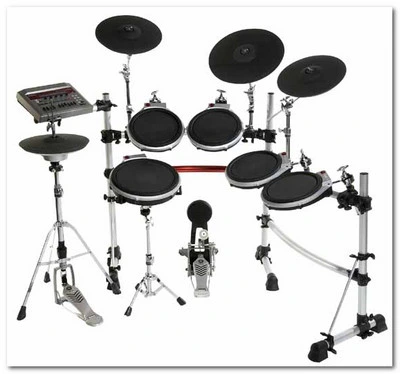
After jumping right into Facebook Ads Manager’s Ad Set without figuring out your customer avatar, you decide to use the Ad Set level targeting tool to figure out who to target for your electronic padded drum set.
You might have even written down a small list of things prospects might like or do, so you begin with the Facebook Targeting tool.
You might come up with an audience who aligns with the following characteristics:
- Likes Rolling Stone Magazine
- Likes Drum! Magazine
- Identifies themselves as a musician
- Likes TAMA (a drum brand)
Sounds like things drummers would like, right?
Here’s food for thought:
It’s possible for two people to share all the interests above and still be completely different people from two different environments.
W still have to tailor our message to both of them correctly. In fact, zeroing in on the correct avatar to advertise to may influence the first targeting we did in the Facebook Tool.
Let’s look at two different avatars:
- Person A is a dentist who moonlights as a drummer in a jazz band on the weekends.
- Person B is a heavy metal drummer who drums for a living and tours from state to state.
- Both people are ideal candidates for your product. With electronic drums, you can throw on the headphones and rock out without disturbing your 90-year-old neighbor watching Wheel of Fortune.
- Both people follow hip news related to the music industry and subscribe to Rolling Stone Magazine and Drum! Also, both people might happen to be drumming on TAMA sets.
But should you speak to these people the exact same way? Do you think both of them would respond to the same message and hook? Probably not.
Even your ad creatives should probably look different.
The dentist might be more interested in preventing his neighbors from hating him while the heavy metal rocker might be interested in portability for his travels.
Let’s come up with one more avatar—a teenager who is learning to play the drums.
A good idea might be to target the kids’ parent with this headline, “Got a teenager who plays drives you nuts on the drums?”
Now, let’s backtrack to the garlic press—here are a few sample avatars which could be expanded upon:
- Cook or Chef who works in a busy restaurant in a busy city
- Me—a busy entrepreneur who eats healthy and cooks healthy dishes for his family where time is an issue
- A healthy home cook who loves the outdoors and camping
- Owner of a local health food store in a small (or big) town
We all might love the cooking channel. We all might love discovering new recipes online and in magazines, but you’d tailor your message to them in different ways.
Better understanding your avatar can influence your settings on the Facebook Targeting tool.
Google is my personal best friend when it comes to researching my customer avatar and so is my customer list. Use your resources.
Tip: Survey Your Customers to Learn More About Who’s Buying Your Stuff
My customer list primarily comes from two lead magnets, my Facebook Ads and packaging inserts.
The insert has one goal. It urges customers to click on a specific URL that leads them to register for product warranty and watch an unboxing video.
The URL is a simple one, like mysite.com/warranty. It redirects to the actual Typeform page that asks customers for their name, email, etc. But the page also asks two more critical questions:
![]()
![]()
If they opt-in and agree to receive coupons, I put them in a segmented list or a list all on their own.
If we can get the customer to answer a question or two about why they bought our product and learned a little about the situation they’re in, we can begin to craft better Amazon Facebook ads.
The information I gather from the questions I ask from my customers help me craft better Facebook ads.
Digging deep into uncovering various customer avatars is beyond the scope of this blog post, but Digital Marketer has an excellent article on this subject (and free downloadable worksheets), “The Customer Avatar Worksheet: Finally, Get Clear on WHO You Are Selling To!“
What If You Have A Unique Product No One Knows About?
A unique yet unknown product is definitely a tougher sell if you’re trying to sell to a cold audience. If you have a new product that people are totally unaware of, then you have more hills to climb:
- They might not be aware they have the problem to begin with
- They have zero brand awareness
- They might not understand how your product will benefit them
Your best bet would be to build warm audiences by doing the following:
- Running some ‘Like’ campaigns for your business page.
- Sending traffic to your website where you can install a pixel on them for retargeting, and they can read a blog article about something interesting (make sure it relates to your product).
- Have a lead magnet or what we digital marketers call a “tripwire.”
Here’s some news you’ll like. If you’re running a CPR promotion with an excellent offer, your hook doesn’t have to be as strong.
You also more likely to find more success with cold audiences—that doesn’t mean you should skip a good hook, by the way.
If you are launching a CPR promotion for a largely unknown product with a good email list or following, then try running a Facebook ad with longer text to convince prospects to take the offer.
Here’s a good general marketing tip to follow.
If you’re dealing with a product people are unfamiliar with, then comparing it to something people are familiar with is a good idea (like a metaphor).
Here’s an example. Before I got into the keto/paleo diet to become a health-minded person, I knew nothing about probiotics and gut bacteria—but I was a big Star Trek fan.
(Yes, yes, yes… I’m going to work a Borg into my case study on selling supplements! Isn’t marketing so much fun? It’s okay to play around with it, but be smart.)
If I were to see a Facebook ad about your probiotic supplement or the dangers of not having enough gut bacteria—which is something I’m totally unaware of—it would go right above my head.
What would be a good way to capture my attention and read your long Facebook ad copy to convince me that I need your supplements NOW?
Incorporating a metaphor I can understand what you’re selling would be a smart thing to do.
“Probiotics – It’s the Borg Nanites Of the Human Body”
(If you’re a Star Trek fan, you’ll get this.)
Your Facebook Ad’s Relevance Score
Facebook scores your ads with a relevance score between 1 and 10 with 10 being the best.
This score is important for a number of reasons:
- The higher the score, the less per click you pay (cha-ching!)
- This score can tell you just how well your ad is resonating with people. Use this as a gauge to decide whether or not you should consider tweaking your ad
- If your score is too low, it can actually make you pay more per click in other campaigns
Personally, if my relevance score is below 5, I know I’ve got work to do. If it’s a 5 or 6, I’m relatively happy although I might try making it a little better.
One important thing to note: Your relevance score won’t show up immediately. Facebook must let your ad run for a little while to gather data.
After gathering the data, Facebook assigns your ad a score based on your audience’s engagement level.
If you initially see a relatively low score, you might want to let it run just a bit longer before re-optimizing. Often, my scores start out at a 3 but quickly climb the ranks after some audience interaction.
Campaign Objectives
Creating a campaign is the first step to setting up ads using Facebook Ads Manager.
You might be wondering why I saved this section for last.
It’s because good business plans begin with the end in mind. Getting a full and complete picture of where you’re going, how you’re going to get there, and who you’re planning to meet before you embark on the journey is best.
When choosing your campaign objective, you must approach the choice like a captain of a football team. There is a large roster of options, and it’s your job to decide which roster will produce the best ad performance.
See that? I just created a metaphor to explain campaign objectives.
You wouldn’t pick a punter to be your quarterback. Nor would you pick a center (the big guy who hikes the ball and protects the quarterback) to be your wide receiver.
Picking a campaign objective is kind of like picking who you want to play the game with.
Facebook categorizes its users into:
- Clickers
- Buyers
- Likers
- Commentators, etc.
You have the option of choosing which category to reach out to.
For our purpose of this blog, we’ll focus on the category of people who are most likely to click, visit a webpage off Facebook, and buy something. Typically, it’s best to choose the “Traffic” or “Conversion” objective to achieve this.
If you’re a more advanced advertiser, you can set up preceding campaigns to build warmer audiences before urging them to buy. But since this article focuses on Facebook advertising strategy for CPR promotions, the Traffic or Conversion objectives will be your best bet.
On a side note—aside from Store Visits—these are the only two campaign objectives available to create a Facebook Offer ad type.
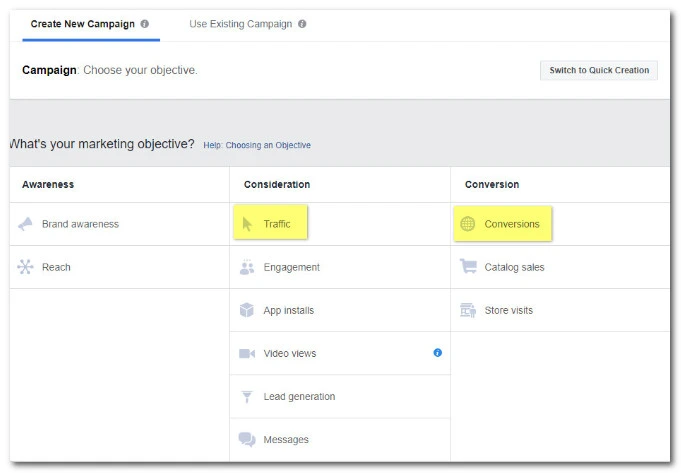
So, now that we know which objectives to choose from, which one should you go with?
Remember, Facebook categorizes users into clickers, likers, buyers, etc.?
Let’s break the two campaign objectives down.
Traffic Objective
If you want to lead prospects to your website or landing page without taking specific actions, this is the best objective to choose.
It’s a great objective to choose if you’re looking to build a warm audience by directing prospects to a blog article or a piece of content.
For coupon promotions, I always optimize the ad delivery for “Landing Page Views” (visible in the Ad set level for targeting).
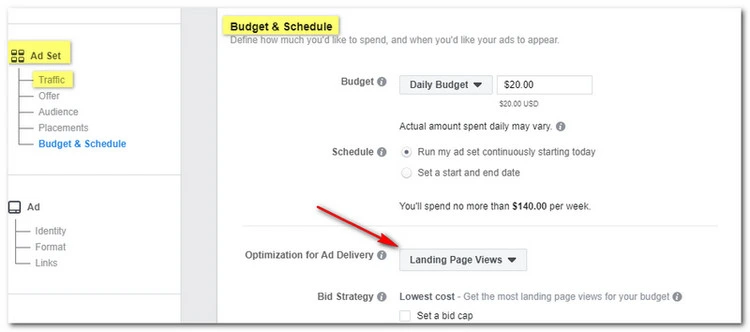
At first glance, it might not seem to be the right objective.
After all, we want them to visit a specific site (Amazon) and do something specific—to use our coupon to BUY!
Now, let’s take a look at the Conversion objective and circle back to why the Traffic objective is still a good choice to consider.
Conversion Objective
This objective is designed to display your Facebook ads in front of people who are most likely to enter their email address to claim a coupon, engage with a lead magnet, or convert into a sale.
If you’re looking to sell, the Conversion objective is a great option.
Lets circle back to why the Traffic objective is still worth considering.
First, the Conversion objective requires the use of a Facebook Pixel. The pixel should be installed on your website, specifically on whatever page you believe someone should land on to be considered a “conversion”.

That means you need a full marketing funnel to lead prospects off Facebook, get them to give you their emails, land them on a “Thank You” page, then direct them to Amazon.
In short, this requires your own website and landing pages.
You can’t just place a pixel on your Amazon page to use the Conversion objective.
This is why I used Traffic campaigns rather than Conversions campaigns in my Facebook tutorials—because that allows me to send prospects straight to my Amazon listing.
But here’s why you might start with the Conversions campaign but switch to a Traffic campaign later:
If your ad isn’t converting, then Facebook’s algorithm is going to have a hard time figuring out who it should be optimizing for. Facebook will be unsure of which people it should display your ad to because it doesn’t have data to make decisions.
If your ad lacks conversions, then you might want to give it a second glance and review your landing page.
You might get better results with a Traffic campaign since it’ll at least make it more likely for people to click on your Facebook ads to land on websites outside of Amazon.
Conclusion
If you’ve read this entire blog post on creating effective Amazon Facebook ads, leave a comment below and let me know—because you rock! There’s a lot of information packed into this article, and I’d love to hear your comments.
Here’s a very brief recap.
Facebook is an interruption advertising platform, and users are not there to buy your product right now.
It’s our job as savvy digital marketers to get them to stop what they’re doing and pay attention to what we are saying and offering.
We do this by capturing their attention through interesting, sometimes color-clashing creatives which might tell some kind of story (a picture is worth a 1000 words).
Once we have their attention, it’s time to tell them about our offer, but to sell it, we’ll have to use a hook (how our product will benefit them).
Targeting is not just about demographics. A complete targeting strategy includes two things:
- Demographics (which we can use tools to uncover)
- Messaging (calling them out in the ad [e.g. “Teachers!”])
If you’re running a CPR promotion with Facebook ads, and you don’t see sales traction even after a 90% discount, try changing up your ad a little. Most often than not, it can be that your messaging isn’t resonating with the audience even if your demographic targeting is spot on. Try a longer copy like the one below:
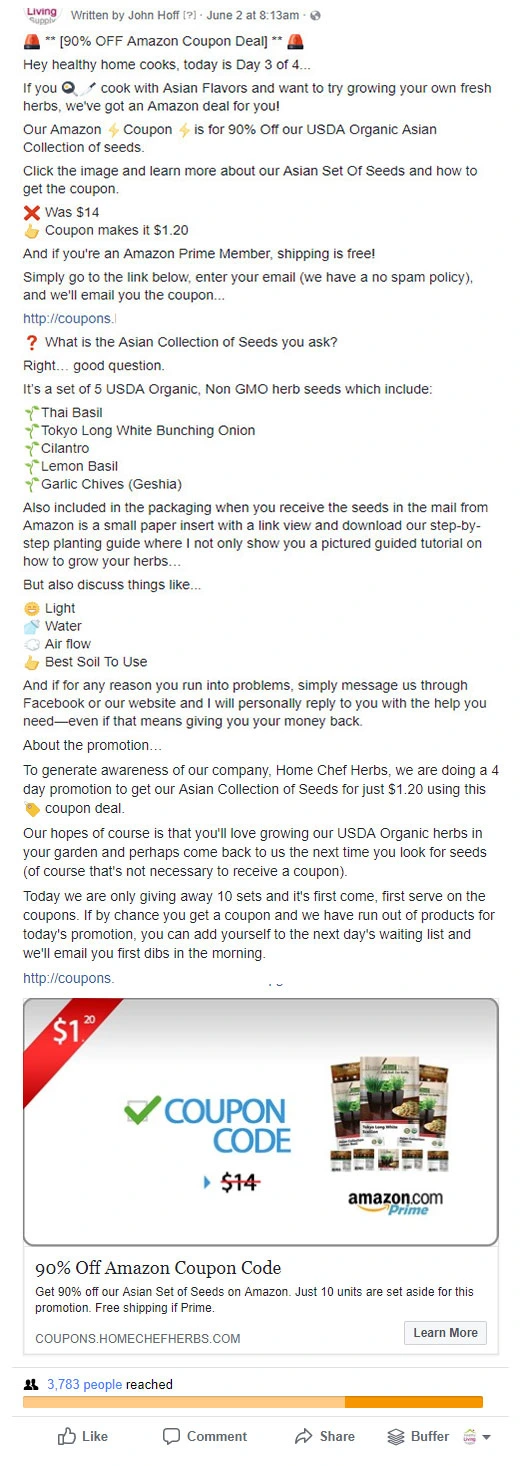
This ad performed well with a relevance score of 7. I managed to give away all the coupons I wanted in a very short amount of time (Something like 40 minutes). Other times, a shorter ad with a few emojis might work well for you.
I hope you found this article informative. I had a lot of fun writing it and I look forward to chatting with you in the comments below or in the Facebook page(or FBA High Rollers).
